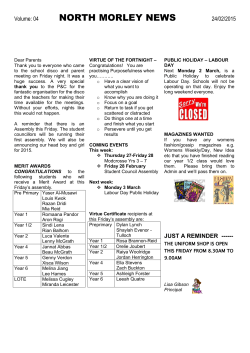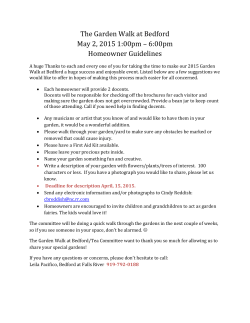
April 2015 - Center For The Study Of The Black Belt
Pursue Sustainability A publication of the Black Belt Conservation and Research Institute The University of West Alabama Vol. 1 No. 5 April 2015 Sus.tain’a.bil’i.ty n. Earth Day celebrated worldwide The ability to meet the needs of the present without compromising the the ability of future generations to meet their needs. Inside this issue: Earth Day Rules to recycle by Steps to sustainable lawn care Page 1 Page 2 Page 2 WORD OF THE MONTH Pesticide Any substance used to kill, repel, or control certain plants and animal life that are considered pests. Livingston Recycle Center Schedule Location: Livingston South Industrial Park 100 Bennett Road Livingston, Alabama 35470 Hours of Operation: Wednesday from 10 a.m. - 6 p.m. Saturday from 8 a.m. - Noon Celebrating its 45th anniversary, Earth Day, celebrated each April 22, is the largest, most celebrated environmental event worldwide. How did Earth Day begin? By the 1960s people were becoming aware of the effects of pollution on the environment. In 1962, Rachel Carson’s bestselling “Silent Spring” raised the awareness of pesticides pollutants. In 1969 a fire broke out in Cleveland’s Cuyahoga River that raised the issue with chemical waste disposal. Until this time, protecting the Earth’s natural resources was not on the government’s agenda. In 1970, Earth Day was launched separately by activist John McConnell and Senator Gaylord Nelson asking Americans to participate in grassroots demonstrations. Due to the public’s awareness, a number of important pieces of environmental legislation were passed in the 1970’s— the Clean Air Act, the Water Quality Improvement Act, the Endangered Species Act, the Toxic Substances Control Act and the Surface Mining Control and Reclamation Act. Earth Day has certainly grown and continues to do so with the help of Earth Day Network (EDN) a non-profit group that organizes and coordinates Earth Day activities. Since 1990, over 140 nations have participated with EDN. Today EDN collaborates with 17,000 partners in 174 countries. UWA Call For Action! One billion people will participate in Earth Day activities. You can be part of the group by celebrating Earth Day at UWA. On Wednesday, April 22, the UWA community is encouraged to do two simple things pick-up litter and recycle. Enjoy the beautiful campus of UWA and Happy Earth Day. Recycling Rules Steps to sustainable lawn care Ninety-two percent of American’s think recycling is good for the environment. That doesn’t mean we like to do it. Here’s a list of pet peeves and tips to make recycling easier. A lawn that is well-established and healthy can out-compete most weeds and withstand a certain amount of stress from drought, insects, and disease. Lawns can often be restored simply by improving management such as proper fertilization, mowing, watering, and addressing problems with thatch and soil compaction. Who We Are Let it grow Strengthen the roots– allow lawn growth of 4.5 inches then cut it down to 3 inches. Mulch the trims After clipping your shrubs, deposit the trims into the soil for nutrients. Air it out During the fall, air your lawn using an aerator to give it the oxygen it needs. Soil test Doing a soil test will indicate the nutrients your lawn is missing. Water less often A healthy lawn only needs about 1 inch of water. Give your lawn a good sprinkle once a week instead of daily. Embrace certain weeds Dandelions provide natural aeration and clovers take nitrogen from the air and place it back into the soil. 2 Pet peeves: • 33% of recyclers are bothered when they see others who aren’t recycling in public places. • 24% of American recyclers don’t like not being able to recycle certain types of materials (Ex: plastic and paper) • 1 in 4 Americans are annoyed by overflowing or hard to find recycling bins. • 1 in 10 Americans don’t know what the local recycling laws are. Tips: • Keep paper clean (Dirty tissues, paper towels, paper plates and greasy boxes are not welcomed) • Glass (Keep the little broken pieces of glass out of the recycle) • Aluminum (Cans are a constant doovers, recycle them!) • Plastic (The number located on the bottle tells you what polymer it is. ©Consumer Reports Smart Gardening Scenarios The Yard-to-Table Garden With a little bit of work and some water you can create an edible garden in your backyard. Raising the bed and using nutrient rich soil is key to having a happy garden. Your garden will need full sun and a drip system for irrigation putting water directly into the root system. What should you grow? Whatever your stomach desires. Create a fruit stand by planting strawberries or make a salad bar by planting lots of greens. The Wildlife-Loving Garden Butterflies and bees are disappearing more each year. The monarch butterfly had its lowest count in 2014 and the bees are also low in numbers. Plant a garden that will make these species happy. Milkweed and honeysuckle will provide nectar and pollen to a variety of pollinators. You may even want to try “birdscaping,” by adding berry plants and thorny trees to offer protection for bird nests. Do some research and discover other plants you can use in your garden that are loved by bees and butterflies— but will not be bothered by deer and other pests. The Water-Smart Garden With the U.S. experiencing dry conditions, water-smart landscaping is becoming a necessity. A water-smart garden is not just cacti. Traditional gardens can be water-smart, too. Plant native plants in your region that are adapted to the local water conditions and add a layer of mulch to help retain the moisture. Use rain barrels to catch runoff water from the roof and air-conditioning unit. Also, use an irrigation system that has a soil sensor so the garden only gets watered as needed. ©Consumer Reports Wildlife friendly gardens attract numerous species including the monarch butterfly. The Black Belt Conservation Institute (BBCRI) is a unit within the Division of Educational Outreach at the University of West Alabama (UWA). Current projects include a partneship with the Institute of Sustainability, a green certification agreement to further the University’s ongoing efforts to promote environmental awareness and preservation and the Nature Conservancy for the restoration of prairies. For the past four years, UWA has been recognized by the National Wildlife Federation for its Prairie Land Restoration Project. For more information, contact Lee Stanton, Director, Black Belt Conservation and Research Institute via email at lstanton@uwa.edu, call (205) 652-3145 or visit http://centerforblackbelt.org/units/black-belt-conservation-research-institute/. Pursue Sustainability
© Copyright 2025













